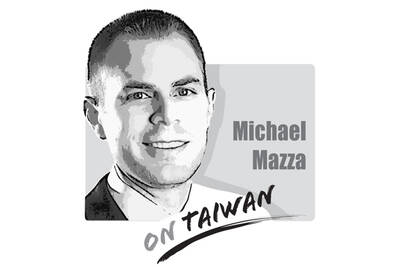If Taiwan needs a sign that the relationship with the US is “at a high water mark,” it only needs to look at the schedule of newly appointed American Institute in Taiwan (AIT) Director Sandra Oudkirk for the past four months.
After assuming the post at the end of July, Oudkirk met with President Tsai Ing-wen (蔡英文) on Aug. 10, when Oudkirk said that “the Taiwan-US relationship is at a high water mark.”
Since then, Oudkirk has kept a packed agenda. From appearing at Taiwan Taoyuan International Airport when Moderna COVID-19 vaccines donated by the US arrived, to traveling to Chiayi County to witness the upgrading of F-16 combat squadrons, to accompanying US congressional delegations to meetings with Tsai and visiting Taiwan Semiconductor Manufacturing Co (TSMC) facilities, there is no question that Oudkirk has been demonstrating the high water mark occasion with tangible actions.
The Global Cooperation and Training Framework (GCTF) is another example.
To resolve the predicaments Taiwan faces in joining international organizations, the US founded the GCTF in 2015, a tailor-made platform to utilize Taiwan’s strengths and expertise to address global issues of mutual concern with the international community, focusing on public health, crime, digital economics, cybersecurity and other fields.
Since assuming her position, Oudkirk has hosted six consecutive workshops with one to two events per month. The topics have included green energy and sustainability, labor rights protection, crisis management and disaster response, women in government, protecting the rights of people with disabilities and countering fake news.
All of these issues are within Taiwan’s areas of expertise, and by standing shoulder to shoulder with the US, the nation can bring to life its slogan of “Taiwan can help” and contribute in a variety of ways to the international community.
Japan became the GCTF’s third partner in 2019, and has since joined Taiwan and the US in cohosting all of its workshops.
Australia also joined the framework in October.
The GCTF alliance can assist Taiwan in becoming central to those countries’ strategies in the Indo-Pacific region.
Additional like-minded countries such as Canada, the UK, Sweden, the Netherlands, Slovakia, Israel and some countries in the EU have joined the GCTF to cohost workshops on a wide range of topics.
Taiwan might be seeing a spillover effect from the GCTF, with a growing number of participating countries and increasing diversity in the topics it covers.
Since the administration of US President Joe Biden took office in January, US Navy vessels have sailed through the Taiwan Strait 11 times, conducting regular freedom of navigation patrols every month. Tsai has also confirmed the presence of US troops in the nation to help train the Taiwanese military.
Meanwhile, a TSMC 5-nanometer wafer plant under construction in Phoenix, Arizona, is to be the US’ largest direct foreign investment in the country’s history.
With defense and supply chain cooperation in place, there is no doubt that the relationship between Taiwan and the US is at a high water mark.
As visits from US government officials and congressional delegations are expected to increase, Oudkirk’s schedule is likely to become busier than ever.
Chen Yung-chang is a company manager.
Translated by Rita Wang
The saga of Sarah Dzafce, the disgraced former Miss Finland, is far more significant than a mere beauty pageant controversy. It serves as a potent and painful contemporary lesson in global cultural ethics and the absolute necessity of racial respect. Her public career was instantly pulverized not by a lapse in judgement, but by a deliberate act of racial hostility, the flames of which swiftly encircled the globe. The offensive action was simple, yet profoundly provocative: a 15-second video in which Dzafce performed the infamous “slanted eyes” gesture — a crude, historically loaded caricature of East Asian features used in Western

Is a new foreign partner for Taiwan emerging in the Middle East? Last week, Taiwanese media reported that Deputy Minister of Foreign Affairs Francois Wu (吳志中) secretly visited Israel, a country with whom Taiwan has long shared unofficial relations but which has approached those relations cautiously. In the wake of China’s implicit but clear support for Hamas and Iran in the wake of the October 2023 assault on Israel, Jerusalem’s calculus may be changing. Both small countries facing literal existential threats, Israel and Taiwan have much to gain from closer ties. In his recent op-ed for the Washington Post, President William
A stabbing attack inside and near two busy Taipei MRT stations on Friday evening shocked the nation and made headlines in many foreign and local news media, as such indiscriminate attacks are rare in Taiwan. Four people died, including the 27-year-old suspect, and 11 people sustained injuries. At Taipei Main Station, the suspect threw smoke grenades near two exits and fatally stabbed one person who tried to stop him. He later made his way to Eslite Spectrum Nanxi department store near Zhongshan MRT Station, where he threw more smoke grenades and fatally stabbed a person on a scooter by the roadside.
Taiwan-India relations appear to have been put on the back burner this year, including on Taiwan’s side. Geopolitical pressures have compelled both countries to recalibrate their priorities, even as their core security challenges remain unchanged. However, what is striking is the visible decline in the attention India once received from Taiwan. The absence of the annual Diwali celebrations for the Indian community and the lack of a commemoration marking the 30-year anniversary of the representative offices, the India Taipei Association and the Taipei Economic and Cultural Center, speak volumes and raise serious questions about whether Taiwan still has a coherent India